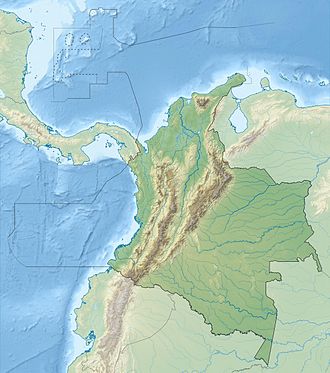Top Qs
Timeline
Chat
Perspective
Paipa-Iza volcanic complex
Colombian volcanic field From Wikipedia, the free encyclopedia
Remove ads
The Paipa–Iza volcanic complex is a volcanic field of Late Pliocene to Early Pleistocene age on the Altiplano Cundiboyacense in the Eastern Ranges of the Colombian Andes. It is the northernmost volcanic complex of the Andean Volcanic Belt with Fueguino in Tierra del Fuego, Chile, at the opposite end of the Andean mountain belt.
The complex, comprising mainly felsic extrusive volcanic rocks as rhyolites, also is the only confirmed volcanic province in the Eastern Ranges, with traces of probably contemporaneous explosive volcanic activity in the vicinity of Guatavita, Cundinamarca.
The Paipa-Iza volcanic field is important as a touristic site with thermal baths in both Paipa and Iza and is being studied for the potential of geothermal energy production and for the extraction of uranium in the area.
Remove ads
Etymology
The names Paipa and Iza originate in Muysccubun, the language of the indigenous Muisca, who inhabited the Altiplano Cundiboyacense before the Spanish conquest. Paipa was the name of a cacique who served under cacique Tundama of Duitama and Iza means "place of healing".[1]
Geography
Summarize
Perspective
The Paipa–Iza volcanic complex is located in the northern part of the Altiplano Cundiboyacense at altitudes between 2,500 and 2,770 metres (8,200 and 9,090 ft). The northwestern part of the complex is situated in the municipality Paipa and the southeastern part in Iza, both belonging to the department of Boyacá.
Climate
Remove ads
Paipa–Iza volcanic complex

The complex was active from the late Pliocene, around 2.7 Ma, until the earliest Pleistocene, around 2.3 Ma.[2][3][4][5]
The complex at Iza consists of two domes; Domo Holcim with 0.67 square kilometres (7,200,000 sq ft) and Domo Los Sauces 0.12 square kilometres (30 acres) in size. They consist of porphyritic rhyolites with sanidine and plagioclase as dominant mineral groups and abundant xenoliths of sedimentary rock and in minor quantities volcanic or metamorphic fragments. The overall rock composition is very felsic and comprises biotites and amphiboles as opaque minerals.[6]
Geothermal energy
The complex is studied for the potential of geothermal energy production.[7][8][9]
Resources
The complex is studied for the potential of uranium mining.[10][11]
Regional geology
See also
References
External links
Wikiwand - on
Seamless Wikipedia browsing. On steroids.
Remove ads



